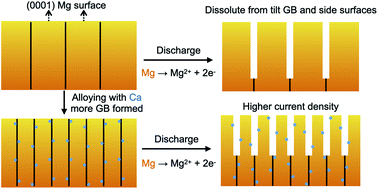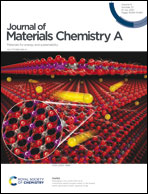Tuning the performance of a Mg negative electrode through grain boundaries and alloying toward the realization of Mg batteries†
Abstract
Persistent magnesium (Mg) dissolution/deposition during cycling is crucial for the practical use of Mg rechargeable batteries, and the alloying-enhanced performance has recently attracted much attention. Nevertheless, the microscopic relationship among the alloys, the defects, and the performance remains under debate. Here, via comprehensive Density Functional Theory calculations, we revealed the effect of alloying-induced grain boundaries (GBs) and demonstrated a microscopic mechanism of how the GBs and alloys affect the performance. Mg atoms at the [0001](10![[1 with combining macron]](https://www.rsc.org/images/entities/char_0031_0304.gif) 0) tilt GB and (11
0) tilt GB and (11![[2 with combining macron]](https://www.rsc.org/images/entities/char_0032_0304.gif) 0) surface are preferentially stripped during discharge, resulting in a “pit-type” morphology. Surprisingly, alloying does not change Mg's dissolution tendency at GBs. Instead, it can tune the number of tilt GBs, as alloying with Ca or Na can create more GBs than alloying with Li, Al, and Zn, resulting in improved discharge performance. Considering the experimental observation, we also propose a new picture of a GB-dependent electrochemical energy diagram extending from the conventional electrochemical theory.
0) surface are preferentially stripped during discharge, resulting in a “pit-type” morphology. Surprisingly, alloying does not change Mg's dissolution tendency at GBs. Instead, it can tune the number of tilt GBs, as alloying with Ca or Na can create more GBs than alloying with Li, Al, and Zn, resulting in improved discharge performance. Considering the experimental observation, we also propose a new picture of a GB-dependent electrochemical energy diagram extending from the conventional electrochemical theory.

- This article is part of the themed collection: Battery science and technology – powered by chemistry


 Please wait while we load your content...
Please wait while we load your content...